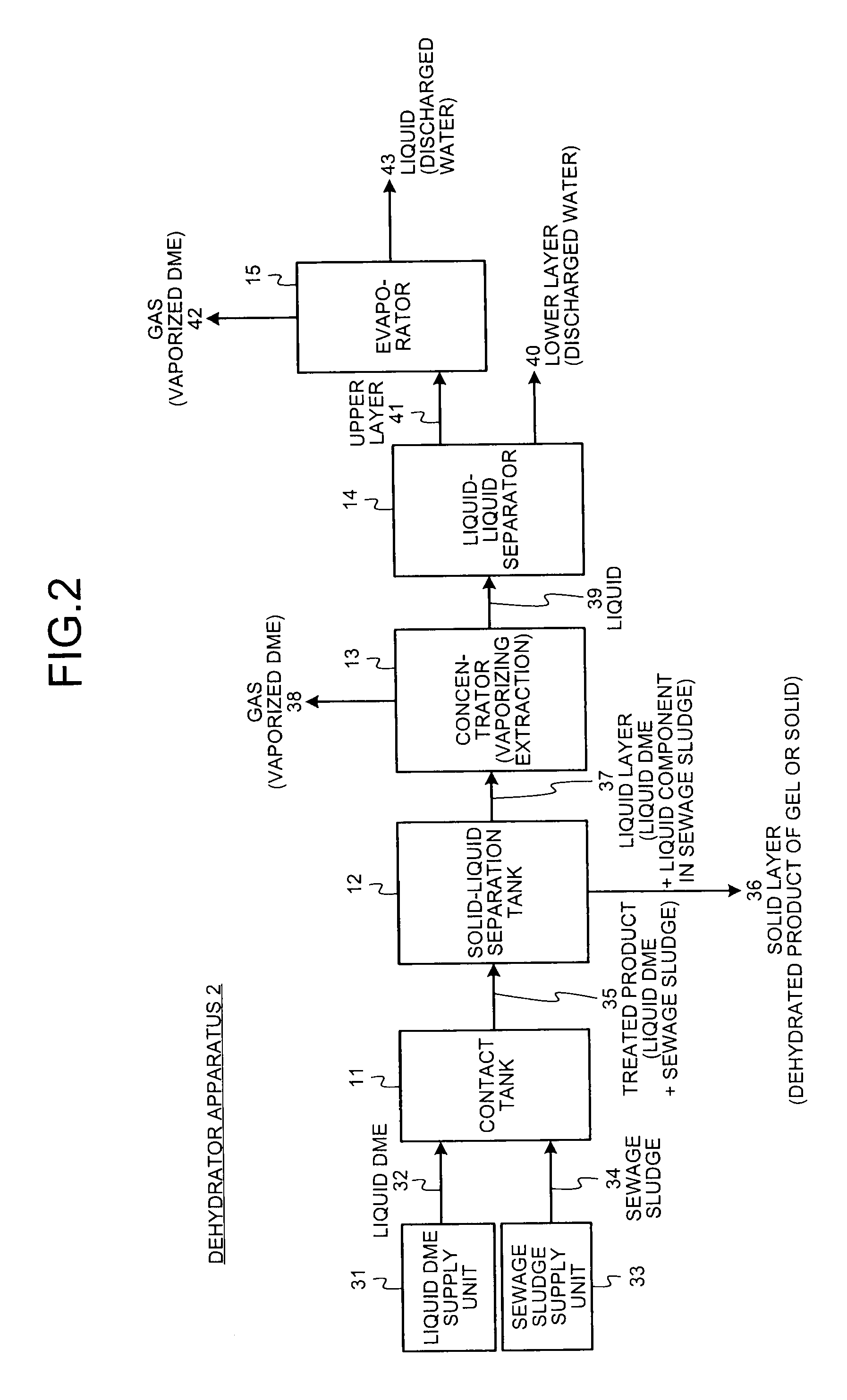Method for treatment of water-containing material
a technology of water-containing materials and treatment methods, which is applied in the direction of liquid degasification, sludge treatment with immiscible liquids, separation processes, etc., can solve the problems of large amount of sewage sludge discharge, difficult implementation, and limit the assuring area to be reclaimed, etc., to achieve efficient treatment and treatment. , the effect of achieving clean water
- Summary
- Abstract
- Description
- Claims
- Application Information
AI Technical Summary
Benefits of technology
Problems solved by technology
Method used
Image
Examples
reference example 1
[0106]The column (hyper glass cylinder HPG10-5 model, made of glass, internal diameter: 11 mm, supplied from Taiatsu Techno Corporation) was filled with 5.0 g of sewage sludge (dehydrated cake, water content: 78% by weight). The volume of the sludge filled in the column was about 4.5 mL (diameter: 11 mm, thickness: 43 mm), and its density was 1.11 g / mL. The column has the full length of 190 mm and the external diameter of the narrowing column mouth of 12.5 mm, and glass beads were densely filled into both back and forth of the column filled with the sewage. Both ends of the column in which the sewage sludge had been filled were provided with pressure gauges, and liquid DME was supplied with 0.42 MPaG from the bottom of the column at the normal temperature.
[0107]The pressure at both ends of the column was measured, and the pressure at the downstream side of liquid DME was 0.0 MPaG whereas the pressure at the upstream side was 0.42 MPaG (nearly saturated vapor pressure). Infiltration ...
reference example 2
[0108]Three containers having the internal volume of 96 mL were prepared, and 5.0 g, 1.0 g and 0.1 g of the sewage sludge (dehydrated cake, water content: 78% by weight) and 30 mL to 35 mL (=20.0 g to 23.3 g) of liquid DME were loaded therein. Contents in each container were stirred using the stirring bar (rotation frequency 600 rpm to 700 rpm), and the state in the container was grossly observed with time.
[0109]In the container in which 5.0 g of the sewage sludge had been loaded, the volume of the sludge swelled to about 38 mL immediately after the liquid DME was added to the container. The volume of the sludge was gradually decreased by stirring, and decreased to about 29 mL one minute after the start of stirring. Subsequently, the stirring was continued for one hour, but the volume of the sewage sludge was not changed.
[0110]In the container in which 1.0 g of the sewage sludge had been loaded, the liquid DME was added to the container and the stirring was started. After about 5 mi...
example 1
[0114]In a “container 1” (made of glass) having the internal volume of 96 mL, 2.15 g of sewage sludge (dehydrated cake, water content: 78% by weight) and 35.0 mL (=23.3 g) of liquid DME was loaded and stirred for 5 minutes (rotation frequency 600 rpm to 700 rpm).
[0115]After stirring for 5 minutes, the mixture was left stand for 10 seconds or more to precipitate the sludge, and subsequently 15.76 g of the supernatant of the liquid DME in the “container 1” was aspirated out and transferred to the “container 2”.
[0116]After the liquid DME in the “container 2” was evaporated under the normal temperature and pressure conditions, and then the resultant was separated by liquid-liquid separation into the DME layer (upper layer) and the water layer (lower layer). The amount of the evaporated DME was 13.00 g. Subsequently, the water layer (lower layer) was aspirated out and transferred to the “container 3”. The amount of the water layer transferred to the container 3 (lower layer) was 0.87 g.
[...
PUM
| Property | Measurement | Unit |
|---|---|---|
| pressure | aaaaa | aaaaa |
| temperature | aaaaa | aaaaa |
| temperature | aaaaa | aaaaa |
Abstract
Description
Claims
Application Information
 Login to View More
Login to View More - R&D
- Intellectual Property
- Life Sciences
- Materials
- Tech Scout
- Unparalleled Data Quality
- Higher Quality Content
- 60% Fewer Hallucinations
Browse by: Latest US Patents, China's latest patents, Technical Efficacy Thesaurus, Application Domain, Technology Topic, Popular Technical Reports.
© 2025 PatSnap. All rights reserved.Legal|Privacy policy|Modern Slavery Act Transparency Statement|Sitemap|About US| Contact US: help@patsnap.com



